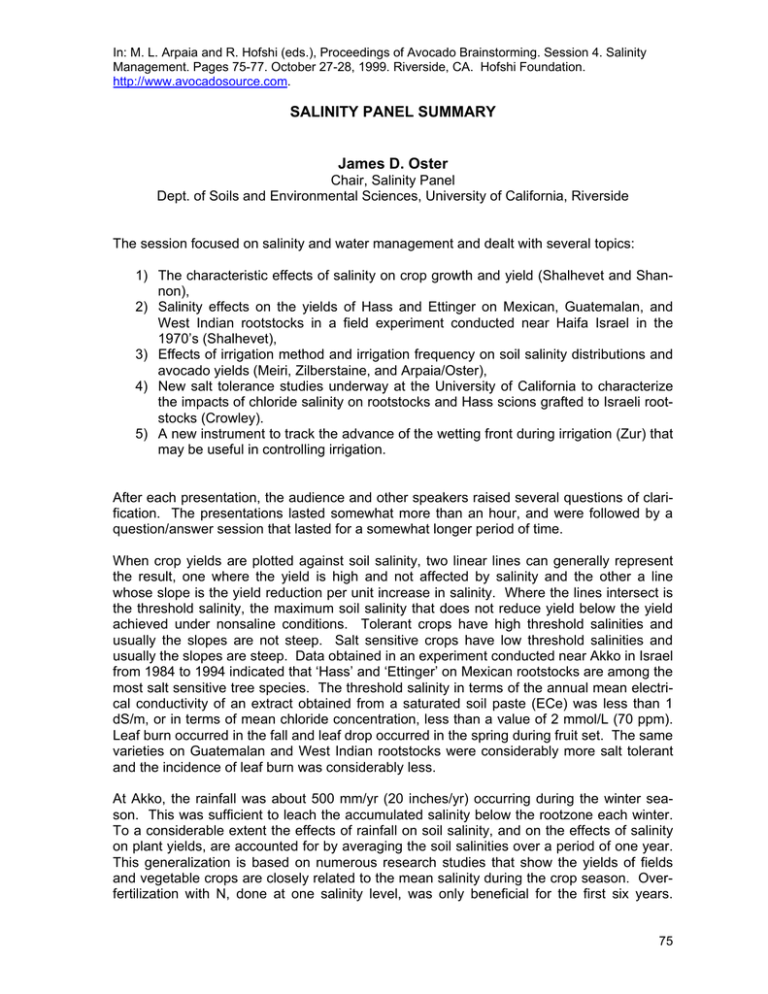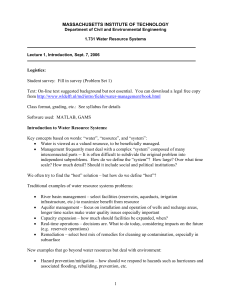In: M. L. Arpaia and R. Hofshi (eds.), Proceedings of... Management. Pages 75-77. October 27-28, 1999. Riverside, CA. Hofshi...
advertisement

In: M. L. Arpaia and R. Hofshi (eds.), Proceedings of Avocado Brainstorming. Session 4. Salinity Management. Pages 75-77. October 27-28, 1999. Riverside, CA. Hofshi Foundation. http://www.avocadosource.com. SALINITY PANEL SUMMARY James D. Oster Chair, Salinity Panel Dept. of Soils and Environmental Sciences, University of California, Riverside The session focused on salinity and water management and dealt with several topics: 1) The characteristic effects of salinity on crop growth and yield (Shalhevet and Shannon), 2) Salinity effects on the yields of Hass and Ettinger on Mexican, Guatemalan, and West Indian rootstocks in a field experiment conducted near Haifa Israel in the 1970’s (Shalhevet), 3) Effects of irrigation method and irrigation frequency on soil salinity distributions and avocado yields (Meiri, Zilberstaine, and Arpaia/Oster), 4) New salt tolerance studies underway at the University of California to characterize the impacts of chloride salinity on rootstocks and Hass scions grafted to Israeli rootstocks (Crowley). 5) A new instrument to track the advance of the wetting front during irrigation (Zur) that may be useful in controlling irrigation. After each presentation, the audience and other speakers raised several questions of clarification. The presentations lasted somewhat more than an hour, and were followed by a question/answer session that lasted for a somewhat longer period of time. When crop yields are plotted against soil salinity, two linear lines can generally represent the result, one where the yield is high and not affected by salinity and the other a line whose slope is the yield reduction per unit increase in salinity. Where the lines intersect is the threshold salinity, the maximum soil salinity that does not reduce yield below the yield achieved under nonsaline conditions. Tolerant crops have high threshold salinities and usually the slopes are not steep. Salt sensitive crops have low threshold salinities and usually the slopes are steep. Data obtained in an experiment conducted near Akko in Israel from 1984 to 1994 indicated that ‘Hass’ and ‘Ettinger’ on Mexican rootstocks are among the most salt sensitive tree species. The threshold salinity in terms of the annual mean electrical conductivity of an extract obtained from a saturated soil paste (ECe) was less than 1 dS/m, or in terms of mean chloride concentration, less than a value of 2 mmol/L (70 ppm). Leaf burn occurred in the fall and leaf drop occurred in the spring during fruit set. The same varieties on Guatemalan and West Indian rootstocks were considerably more salt tolerant and the incidence of leaf burn was considerably less. At Akko, the rainfall was about 500 mm/yr (20 inches/yr) occurring during the winter season. This was sufficient to leach the accumulated salinity below the rootzone each winter. To a considerable extent the effects of rainfall on soil salinity, and on the effects of salinity on plant yields, are accounted for by averaging the soil salinities over a period of one year. This generalization is based on numerous research studies that show the yields of fields and vegetable crops are closely related to the mean salinity during the crop season. Overfertilization with N, done at one salinity level, was only beneficial for the first six years. 75 Thereafter, it resulted in a strong yield reduction in both ‘Ettinger’ and ‘Hass’. The latter effect is consistent with results obtained for field and vegetable crops, where nitrogen, added at levels that exceed the crop requirement, does not reduce the damage due to salinity. Irrigation method and water distribution in the soil – for mature citrus irrigated by drip or micro sprinkler, the wetted volume needs to be at least 30 % of the soil in the orchard based on data obtained for citrus in Israel and avocados in Greece. In a new study underway in Israel, a higher average soil water salinity (2.23 dS/m) in the 0 – 60-cm (0 – 2-ft) depth occurred under daily irrigation than under alternate-day irrigation (3.18 dS/m). This study is located in the coastal plain of Israel where the soil is sandy and the winter rainfall averages 500 mm (20 inches) annually. The trees are ‘Ettinger’ grafted on the salt tolerant rootstock VC51, and the salinity of the irrigation water is 1.4 dS/m with a chloride concentration of 6 mmol/L (212 ppm). In order to apply the same total amount of water over an irrigation season by both irrigation treatments, during an individual irrigation, the volume of applied water in the alternate-day treatment is twice that applied in the daily treatment. Leaching will increase with increasing water applied beneath where the water is applied during an individual irrigation. Consequently, for the alternate-day treatment, the average salinity at 30-cm (1-ft) is lower than that for the daily treatment; likewise the average salinity for the 0 – 60-cm (0 – 2-ft) depth interval is also lower for the alternate-day treatment. Based on the chloride concentrations in the soil water at 60 cm (1 ft), the leaching fractions were the same for both treatments. It follows that although irrigation frequency affected the average soil water salinity in the rootzone and the salinity distribution with depth, it did not affect crop water use. Because total leaching of the rootzone is provided annually by rainfall, the only way to minimize salt loading of the underlying groundwater is to closely match irrigation to crop water needs and to avoid, as much as possible, leaching during the irrigation season. This strategy can result in rapid increases in soil salinity to high levels within the root zone. Monitoring the salinity in the rootzone may provide the necessary feedback information to assure that salinity levels do not exceed acceptable levels during the irrigation season. In California, an irrigation frequency (1/week, 2/week and 7/week) trial was conducted between 1993 and 1997 in San Diego Co with ‘Hass’. The average annual rainfall for the period was 387 mm (15 inches). The salinity of the irrigation water was 1.5 dS/m with a chloride concentration of 2.5 mmol/L (90 mg/L). Applied water was another variable: there were three treatments, 90, 110 and 130% of crop evapotranspiration based on measured potential evaporation using a crop coefficient of 0.65 from May to October and a lower ETc for the remainder of the year. Similar to the frequency experiment in Israel, the average salinities in the 0 – 30-cm (0 – 1-ft) depth interval increased as the frequency increased. Yields increased with increasing applied water. Based on the salinities in the 30 – 120-cm (1 – 4-ft) depth interval measured in the fall, leaching fraction tended to decrease with increasing applied water, an unusual result. This indicates crop water use increased with increasing applied water as did the yield, a result that is consistent with the commonly observed linkage between ET and yield. Increased crop water use and yield is an expected result only if the salinity of the applied water exceeds the threshold salinity of the crop (Letey et al., 1985). This likely was the case. The salinity of the irrigation water was 1.5 dS/m, which exceeds a threshold salinity of less than 1 dS/m as obtained in the Israeli experiment conducted in Akko for ‘Hass’ on Mexican rootstock. Under these circumstances the concept of a fixed crop coefficient to estimate crop ET from measured potential ET does not work. 76 Salt tolerance of avocado is believed to depend on two mechanisms: salt exclusion by roots and osmotic adjustment within the plant. These dual tolerance mechanisms become complicated for grafted seedlings. A rootstock may tolerate salinity through osmotic adjustment that relies on salt uptake but translocates large quantities of sodium and chloride to the scion. Rootstocks also variably affect scion growth thereby affecting the amount of biomass for the dilution of chloride and sodium after translocation. Screening for tolerance thus needs to consider ion accumulation by both the rootsotck and scion and their biomass. Salinity tolerance studies are in progress, at UCR, using ‘Hass’ scions grafted to Israeli rootsock selections that are purportedly able to tolerate high salinities. Two methods are being used. A greenhouse screening trial using a hydroponic culture system in which trees are watered daily with nutrient solutions at a fixed EC, but containing four levels of chloride, 2, 4, 8 and 16 mmol/L (71, 142, 284, and 568 mg/L). In the second method, trees are grown on a saline soil and watered with saline water. The greenhouse experiment allows processing six rootstocks per year and provides a controlled system to study the effects of chloride accumulation on tree physiology. Preliminary results show that the experimental method allows the ready manipulation of choride levels in the trees. The development of an instrument to detect changes in soil water content using the resistivity properties of soils indicates the search continues for a simple tool to provide feedback information to automatically control irrigation. During an irrigation event, the water added to the soil tends to redistribute in the soil as a downward moving pulse. In dry soils this pulse can be seen, in soils packed into Plexiglas columns, as a wetting front, where the soil becomes darker as it wets. The boundary between dark and light colored soil remains sharp as it moves downward. This boundary is the wetting front. The idea of the instrument is to take advantage of the change in the electrical resistance properties across such a front. The dark, or wet, soil will have a lower resistance than the light, or dry, soil. The probe has the capability to measure the soil resistance at several locations along its length. How could such an instrument become a controller of irrigation? A selected resistance, either an average resistance or the level at a specific depth could be used to trigger irrigation, and the reduction of resistance at the lower end of the probe could be used to stop irrigation. Field tests of the probe are currently underway. Reference Letey, J., A. Dinar, and K.C. Knapp. 1985. Crop-water production function model for saline irrigation waters. Soil Sci. Soc. Am. J. 49: 1005-1009. 77





